How Did I Get a Blister on My Foot?

Anyone who enjoys running knows the annoyance of having a blister on their foot. It happens as a result of excess friction that can come from wearing shoes and socks that do not fit correctly. This can damage the skin, and a blister will form over the raw skin as new skin develops underneath it. It is filled with a protective fluid, and will gradually drain as the new skin forms. Blisters can make it difficult to walk, exercise, or stand for extended periods of time, and may be covered with a bandage to prevent premature draining. There are medical conditions many people have that may lead to getting blisters. These can include fungal infections, chickenpox, and eczema. Additionally, blisters may develop from an allergic reaction to an insect bite, or possibly from chemical exposure. It is ideal to prevent blisters from occurring, and this may be done by wearing shoes that fit correctly, applying foot powder to shoes and socks, and wearing socks that can absorb moisture. If you would like more information about how to treat and prevent blisters on the feet, please consult with a podiatrist.
Blisters may appear as a single bubble or in a cluster. They can cause a lot of pain and may be filled with pus, blood, or watery serum. If your feet are hurting, contact Dr. Joshua David Scoll of Pennsylvania. Our doctor can provide the care you need to keep you pain-free and on your feet.
Foot Blisters
Foot blisters are often the result of friction. This happens due to the constant rubbing from shoes, which can lead to pain.
What Are Foot Blisters?
A foot blister is a small fluid-filled pocket that forms on the upper-most layer of the skin. Blisters are filled with clear fluid and can lead to blood drainage or pus if the area becomes infected.
Symptoms
(Blister symptoms may vary depending on what is causing them)
- Bubble of skin filled with fluid
- Redness
- Moderate to severe pain
- Itching
Prevention & Treatment
In order to prevent blisters, you should be sure to wear comfortable shoes with socks that cushion your feet and absorb sweat. Breaking a blister open may increase your chances of developing an infection. However, if your blister breaks, you should wash the area with soap and water immediately and then apply a bandage to the affected area. If your blisters cause severe pain it is important that you call your podiatrist right away.
If you have any questions, please feel free to contact one of our offices located in Philadelphia and Bensalem, PA . We offer the newest diagnostic and treatment technologies for all your foot care needs.
How Did I Get a Blister on My Foot?

Anyone who enjoys running knows the annoyance of having a blister on their foot. It happens as a result of excess friction that can come from wearing shoes and socks that do not fit correctly. This can damage the skin, and a blister will form over the raw skin as new skin develops underneath it. It is filled with a protective fluid, and will gradually drain as the new skin forms. Blisters can make it difficult to walk, exercise, or stand for extended periods of time, and may be covered with a bandage to prevent premature draining. There are medical conditions many people have that may lead to getting blisters. These can include fungal infections, chickenpox, and eczema. Additionally, blisters may develop from an allergic reaction to an insect bite, or possibly from chemical exposure. It is ideal to prevent blisters from occurring, and this may be done by wearing shoes that fit correctly, applying foot powder to shoes and socks, and wearing socks that can absorb moisture. If you would like more information about how to treat and prevent blisters on the feet, please consult with a podiatrist.
Blisters may appear as a single bubble or in a cluster. They can cause a lot of pain and may be filled with pus, blood, or watery serum. If your feet are hurting, contact Dr. Joshua David Scoll of Pennsylvania. Our doctor can provide the care you need to keep you pain-free and on your feet.
Foot Blisters
Foot blisters are often the result of friction. This happens due to the constant rubbing from shoes, which can lead to pain.
What Are Foot Blisters?
A foot blister is a small fluid-filled pocket that forms on the upper-most layer of the skin. Blisters are filled with clear fluid and can lead to blood drainage or pus if the area becomes infected.
Symptoms
(Blister symptoms may vary depending on what is causing them)
- Bubble of skin filled with fluid
- Redness
- Moderate to severe pain
- Itching
Prevention & Treatment
In order to prevent blisters, you should be sure to wear comfortable shoes with socks that cushion your feet and absorb sweat. Breaking a blister open may increase your chances of developing an infection. However, if your blister breaks, you should wash the area with soap and water immediately and then apply a bandage to the affected area. If your blisters cause severe pain it is important that you call your podiatrist right away.
If you have any questions, please feel free to contact one of our offices located in Philadelphia, Bensalem, and Fairless Hills, PA . We offer the newest diagnostic and treatment technologies for all your foot care needs.
Accessory Navicular Syndrome

The accessory navicular is an extra bone or piece of cartilage on the inner side of the foot, just above the arch. This is congenital, or present at birth. Most people do not have this as it is not part of the normal bone structure. People who have this condition are often unaware that they have it, especially if it does not cause problems. However, some people with this extra bone develop accessory navicular syndrome, which is painful. The pain comes from aggravation to the bone or posterior tibial tendon that can come from trauma (like a foot or ankle sprain), chronic irritation (from friction from shoes rubbing against the extra bone), or prolonged activity or overuse. Many of those with this affliction also have flat feet or fallen arches. Having flat feet puts more strain on the posterior tibial tendon, and this can cause inflammation or irritation of the accessory navicular. Symptoms of this syndrome usually appear in adolescence when the bones are mature and cartilage develops into bone. Signs and symptoms of this condition include a visible bony prominence with redness or swelling on the inside of the foot, just above the arch, and a vague pain or throbbing in the midfoot and arch areas, usually after periods of activity. If you or your child have pain in this area of the foot, please see a podiatrist for proper diagnosis and appropriate treatment.
Congenital foot problems require immediate attention to avoid future complications. If you have any concerns, contact Dr. Joshua David Scoll of Pennsylvania. Our doctor can provide the care you need to keep you pain-free and on your feet.
Congenital foot problems are deformities affecting the feet, toes, and/or ankles that children are born with. Some of these conditions have a genetic cause while others just happen. Some specific foot ailments that children may be born with include clubfeet, polydactyly/macrodactyly, and cleft foot. There are several other foot anomalies that can occur congenitally. What all of these conditions have in common is that a child may experience difficulty walking or performing everyday activities, as well as trouble finding footwear that fits their foot deformity. Some of these conditions are more serious than others. Consulting with a podiatrist as early as possible will help in properly diagnosing a child’s foot condition while getting the necessary treatment underway.
What are Causes of Congenital Foot Problem?
A congenital foot problem is one that happens to a child at birth. These conditions can be caused by a genetic predisposition, developmental or positional abnormalities during gestation, or with no known cause.
What are Symptoms of Congenital Foot Problems?
Symptoms vary by the congenital condition. Symptoms may consist of the following:
- Clubfoot, where tendons are shortened, bones are shaped differently, and the Achilles tendon is tight, causing the foot to point in and down. It is also possible for the soles of the feet to face each other.
- Polydactyly, which usually consists of a nubbin or small lump of tissue without a bone, a toe that is partially formed but has no joints, or an extra toe.
- Vertical talus, where the talus bone forms in the wrong position causing other bones in the foot to line up improperly, the front of the foot to point up, and the bottom of the foot to stiffen, with no arch, and to curve out.
- Tarsal coalition, when there is an abnormal connection of two or more bones in the foot leading to severe, rigid flatfoot.
- Cleft foot, where there are missing toes, a V-shaped cleft, and other anatomical differences.
- Macrodactyly, when the toes are abnormally large due to overgrowth of the underlying bone or soft tissue.
Treatment and Prevention
While there is nothing one can do to prevent congenital foot problems, raising awareness and receiving neonatal screenings are important. Early detection by taking your child to a podiatrist leads to the best outcome possible.
If you have any questions please feel free to contact one of our offices located in Philadelphia and Bensalem, PA . We offer the newest diagnostic tools and technology to treat your foot and ankle needs.
Accessory Navicular Syndrome

The accessory navicular is an extra bone or piece of cartilage on the inner side of the foot, just above the arch. This is congenital, or present at birth. Most people do not have this as it is not part of the normal bone structure. People who have this condition are often unaware that they have it, especially if it does not cause problems. However, some people with this extra bone develop accessory navicular syndrome, which is painful. The pain comes from aggravation to the bone or posterior tibial tendon that can come from trauma (like a foot or ankle sprain), chronic irritation (from friction from shoes rubbing against the extra bone), or prolonged activity or overuse. Many of those with this affliction also have flat feet or fallen arches. Having flat feet puts more strain on the posterior tibial tendon, and this can cause inflammation or irritation of the accessory navicular. Symptoms of this syndrome usually appear in adolescence when the bones are mature and cartilage develops into bone. Signs and symptoms of this condition include a visible bony prominence with redness or swelling on the inside of the foot, just above the arch, and a vague pain or throbbing in the midfoot and arch areas, usually after periods of activity. If you or your child have pain in this area of the foot, please see a podiatrist for proper diagnosis and appropriate treatment.
Congenital foot problems require immediate attention to avoid future complications. If you have any concerns, contact Dr. Joshua David Scoll of Pennsylvania. Our doctor can provide the care you need to keep you pain-free and on your feet.
Congenital foot problems are deformities affecting the feet, toes, and/or ankles that children are born with. Some of these conditions have a genetic cause while others just happen. Some specific foot ailments that children may be born with include clubfeet, polydactyly/macrodactyly, and cleft foot. There are several other foot anomalies that can occur congenitally. What all of these conditions have in common is that a child may experience difficulty walking or performing everyday activities, as well as trouble finding footwear that fits their foot deformity. Some of these conditions are more serious than others. Consulting with a podiatrist as early as possible will help in properly diagnosing a child’s foot condition while getting the necessary treatment underway.
What are Causes of Congenital Foot Problem?
A congenital foot problem is one that happens to a child at birth. These conditions can be caused by a genetic predisposition, developmental or positional abnormalities during gestation, or with no known cause.
What are Symptoms of Congenital Foot Problems?
Symptoms vary by the congenital condition. Symptoms may consist of the following:
- Clubfoot, where tendons are shortened, bones are shaped differently, and the Achilles tendon is tight, causing the foot to point in and down. It is also possible for the soles of the feet to face each other.
- Polydactyly, which usually consists of a nubbin or small lump of tissue without a bone, a toe that is partially formed but has no joints, or an extra toe.
- Vertical talus, where the talus bone forms in the wrong position causing other bones in the foot to line up improperly, the front of the foot to point up, and the bottom of the foot to stiffen, with no arch, and to curve out.
- Tarsal coalition, when there is an abnormal connection of two or more bones in the foot leading to severe, rigid flatfoot.
- Cleft foot, where there are missing toes, a V-shaped cleft, and other anatomical differences.
- Macrodactyly, when the toes are abnormally large due to overgrowth of the underlying bone or soft tissue.
Treatment and Prevention
While there is nothing one can do to prevent congenital foot problems, raising awareness and receiving neonatal screenings are important. Early detection by taking your child to a podiatrist leads to the best outcome possible.
If you have any questions please feel free to contact one of our offices located in Philadelphia, Bensalem, and Fairless Hills, PA . We offer the newest diagnostic tools and technology to treat your foot and ankle needs.
Ingrown Toenails May Become Infected if Not Treated Promptly
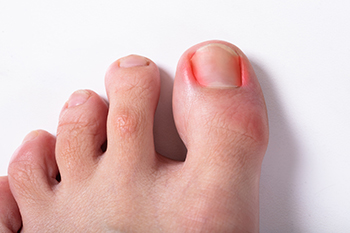
An ingrown toenail is easy to notice. The side of the toenail grows into the skin instead of over it. It can be quite uncomfortable, and in severe cases, may bleed, and become infected. It can happen for a variety of reasons, such as wearing shoes that do not have enough room in the toe area, having endured a toe injury, or from trimming the toenails improperly. Genetic reasons may contribute to getting an ingrown toenail, and this may account for people who naturally have curved toenails, or have toenails that are too large for their toes. Common symptoms that are associated with ingrown toenails include redness, swelling, and pain. The affected toe may temporarily feel better when it is soaked in warm water, which can soften the nail. This may make it easier to pull the skin away from the toe, despite the fact it may not last. If you have an ingrown toenail, there is a chance it can become infected, and it is strongly advised that you consult with a podiatrist as quickly as possible who can offer professional treatment.
Ingrown toenails can become painful if they are not treated properly. For more information about ingrown toenails, contact Dr. Joshua David Scoll of Pennsylvania. Our doctor can provide the care you need to keep you pain-free and on your feet.
Ingrown Toenails
Ingrown toenails occur when a toenail grows sideways into the bed of the nail, causing pain, swelling, and possibly infection.
Causes
- Bacterial infections
- Improper nail cutting such as cutting it too short or not straight across
- Trauma to the toe, such as stubbing, which causes the nail to grow back irregularly
- Ill-fitting shoes that bunch the toes too close together
- Genetic predisposition
Prevention
Because ingrown toenails are not something found outside of shoe-wearing cultures, going barefoot as often as possible will decrease the likeliness of developing ingrown toenails. Wearing proper fitting shoes and using proper cutting techniques will also help decrease your risk of developing ingrown toenails.
Treatment
Ingrown toenails are a very treatable foot condition. In minor cases, soaking the affected area in salt or antibacterial soaps will not only help with the ingrown nail itself, but also help prevent any infections from occurring. In more severe cases, surgery is an option. In either case, speaking to your podiatrist about this condition will help you get a better understanding of specific treatment options that are right for you.
If you have any questions please feel free to contact one of our offices located in Philadelphia and Bensalem, PA . We offer the newest diagnostic and treatment technologies for all your foot and ankle needs.
Ingrown Toenails May Become Infected if Not Treated Promptly

An ingrown toenail is easy to notice. The side of the toenail grows into the skin instead of over it. It can be quite uncomfortable, and in severe cases, may bleed, and become infected. It can happen for a variety of reasons, such as wearing shoes that do not have enough room in the toe area, having endured a toe injury, or from trimming the toenails improperly. Genetic reasons may contribute to getting an ingrown toenail, and this may account for people who naturally have curved toenails, or have toenails that are too large for their toes. Common symptoms that are associated with ingrown toenails include redness, swelling, and pain. The affected toe may temporarily feel better when it is soaked in warm water, which can soften the nail. This may make it easier to pull the skin away from the toe, despite the fact it may not last. If you have an ingrown toenail, there is a chance it can become infected, and it is strongly advised that you consult with a podiatrist as quickly as possible who can offer professional treatment.
Ingrown toenails can become painful if they are not treated properly. For more information about ingrown toenails, contact Dr. Joshua David Scoll of Pennsylvania. Our doctor can provide the care you need to keep you pain-free and on your feet.
Ingrown Toenails
Ingrown toenails occur when a toenail grows sideways into the bed of the nail, causing pain, swelling, and possibly infection.
Causes
- Bacterial infections
- Improper nail cutting such as cutting it too short or not straight across
- Trauma to the toe, such as stubbing, which causes the nail to grow back irregularly
- Ill-fitting shoes that bunch the toes too close together
- Genetic predisposition
Prevention
Because ingrown toenails are not something found outside of shoe-wearing cultures, going barefoot as often as possible will decrease the likeliness of developing ingrown toenails. Wearing proper fitting shoes and using proper cutting techniques will also help decrease your risk of developing ingrown toenails.
Treatment
Ingrown toenails are a very treatable foot condition. In minor cases, soaking the affected area in salt or antibacterial soaps will not only help with the ingrown nail itself, but also help prevent any infections from occurring. In more severe cases, surgery is an option. In either case, speaking to your podiatrist about this condition will help you get a better understanding of specific treatment options that are right for you.
If you have any questions please feel free to contact one of our offices located in Philadelphia, Bensalem, and Fairless Hills, PA . We offer the newest diagnostic and treatment technologies for all your foot and ankle needs.
Signs of Poor Circulation in the Feet
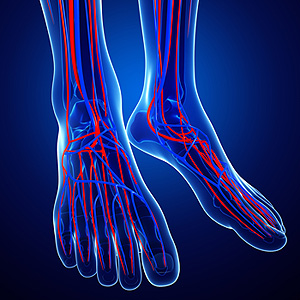
A variety of individuals across the country may exhibit poor circulation in their feet at some point in their lives. Poor circulation is essentially caused when the feet do not receive adequate blood flow. Certain individuals are more susceptible to this condition than others, such as those who have diabetes, high cholesterol, high blood pressure, or a habit of smoking cigarettes. There are a number of signs that can point to poor circulation in the feet. First, if you have poor circulation, the temperature of your feet might be manipulated. For example, your feet may feel colder than usual. Additionally, you might lose feeling in your feet, experiencing numbness of some kind. If you are suffering from poor circulation in the feet, it is possible that you might even notice hair loss around the feet area. If you discover that the skin on your feet has become significantly cracked and the toenails have become brittle, this might be another sign of poor circulation to the feet. If you are exhibiting these signs, consider consulting with a podiatrist to determine whether or not you are suffering from poor circulation. Together, you can draw up a plan to address the problem and increase blood flow to your feet.
Poor circulation is a serious condition and needs immediate medical attention. If you have any concerns with poor circulation in your feet contact Dr. Joshua David Scoll of Pennsylvania. Our doctor will treat your foot and ankle needs.
Poor Circulation in the Feet
Poor blood circulation in the feet and legs is can be caused by peripheral artery disease (PAD), which is the result of a buildup of plaque in the arteries.
Plaque buildup or atherosclerosis results from excess calcium and cholesterol in the bloodstream. This can restrict the amount of blood which can flow through the arteries. Poor blood circulation in the feet and legs are sometimes caused by inflammation in the blood vessels, known as vasculitis.
Causes
Lack of oxygen and oxygen from poor blood circulation restricts muscle growth and development. It can also cause:
- Muscle pain, stiffness, or weakness
- Numbness or cramping in the legs
- Skin discoloration
- Slower nail & hair growth
- Erectile dysfunction
Those who have diabetes or smoke are at greatest risk for poor circulation, as are those who are over 50. If you have poor circulation in the feet and legs it may be caused by PAD and is important to make changes to your lifestyle in order to reduce risk of getting a heart attack or stroke. Exercise and maintaining a healthy lifestyle will dramatically improve conditions.
As always, see a podiatrist as he or she will assist in finding a regimen that suits you. A podiatrist can also prescribe you any needed medication.
If you have any questions please feel free to contact one of our offices located in Philadelphia and Bensalem, PA . We offer the newest diagnostic and treatment technologies for all your foot and ankle needs.
Signs of Poor Circulation in the Feet

A variety of individuals across the country may exhibit poor circulation in their feet at some point in their lives. Poor circulation is essentially caused when the feet do not receive adequate blood flow. Certain individuals are more susceptible to this condition than others, such as those who have diabetes, high cholesterol, high blood pressure, or a habit of smoking cigarettes. There are a number of signs that can point to poor circulation in the feet. First, if you have poor circulation, the temperature of your feet might be manipulated. For example, your feet may feel colder than usual. Additionally, you might lose feeling in your feet, experiencing numbness of some kind. If you are suffering from poor circulation in the feet, it is possible that you might even notice hair loss around the feet area. If you discover that the skin on your feet has become significantly cracked and the toenails have become brittle, this might be another sign of poor circulation to the feet. If you are exhibiting these signs, consider consulting with a podiatrist to determine whether or not you are suffering from poor circulation. Together, you can draw up a plan to address the problem and increase blood flow to your feet.
Poor circulation is a serious condition and needs immediate medical attention. If you have any concerns with poor circulation in your feet contact Dr. Joshua David Scoll of Pennsylvania. Our doctor will treat your foot and ankle needs.
Poor Circulation in the Feet
Poor blood circulation in the feet and legs is can be caused by peripheral artery disease (PAD), which is the result of a buildup of plaque in the arteries.
Plaque buildup or atherosclerosis results from excess calcium and cholesterol in the bloodstream. This can restrict the amount of blood which can flow through the arteries. Poor blood circulation in the feet and legs are sometimes caused by inflammation in the blood vessels, known as vasculitis.
Causes
Lack of oxygen and oxygen from poor blood circulation restricts muscle growth and development. It can also cause:
- Muscle pain, stiffness, or weakness
- Numbness or cramping in the legs
- Skin discoloration
- Slower nail & hair growth
- Erectile dysfunction
Those who have diabetes or smoke are at greatest risk for poor circulation, as are those who are over 50. If you have poor circulation in the feet and legs it may be caused by PAD and is important to make changes to your lifestyle in order to reduce risk of getting a heart attack or stroke. Exercise and maintaining a healthy lifestyle will dramatically improve conditions.
As always, see a podiatrist as he or she will assist in finding a regimen that suits you. A podiatrist can also prescribe you any needed medication.
If you have any questions please feel free to contact one of our offices located in Philadelphia, Bensalem, and Fairless Hills, PA . We offer the newest diagnostic and treatment technologies for all your foot and ankle needs.
Odorous Feet in Children

Although having smelly feet is not always necessarily cause for serious concern, bad-smelling feet can be bothersome. If your child is complaining about their feet producing a foul odor, there are several things that you need to be aware of. The odor that is being emitted from your child’s feet is caused by bacteria. After your child spends a whole day sweating in a pair of sneakers, for instance, that sweat facilitates the multiplication of bacteria. If your child is not wearing socks, typically this only exacerbates the extent to which the bacteria can grow in your child’s shoes. In certain cases, your child’s shoes might even be home to a type of bacteria named Kyetococcus sedentarius. This bacteria can produce especially foul odors because they release volatile sulfur compounds. If you are concerned about your child’s smelly feet, be sure that they wash their feet and wear a new, clean pair of socks every day and alternate shoes regularly, especially if they get wet or sweaty. See a podiatrist for more ways in which you can protect the health of your child’s feet.
Making sure that your children maintain good foot health is very important as they grow. If you have any questions, contact Dr. Joshua David Scoll of Pennsylvania. Our doctor can provide the care you need to keep you pain-free and on your feet.
Keeping Children's Feet Healthy
Having healthy feet during childhood can help prevent medical problems later in life, namely in the back and legs. As children grow, their feet require different types of care. Here are some things to consider...
Although babies do not walk yet, it is still very important to take care of their feet.
Avoid putting tight shoes or socks on his or her feet.
Allow the baby to stretch and kick his or her feet to feel comfortable.
As a toddler, kids are now on the move and begin to develop differently. At this age, toddlers are getting a feel for walking, so don’t be alarmed if your toddler is unsteady or ‘walks funny’.
As your child gets older, it is important to teach them how to take care of their feet.
Show them proper hygiene to prevent infections such as fungus.
Be watchful for any pain or injury.
Have all injuries checked by a doctor as soon as possible.
Comfortable, protective shoes should always be worn, especially at play.
If you have any questions please feel free to contact one of our offices located in Philadelphia, Bensalem, and Fairless Hills, PA . We offer the newest diagnostic and treatment technologies for all your foot and ankle needs.
The Link Between Diabetes and Cracked Heels
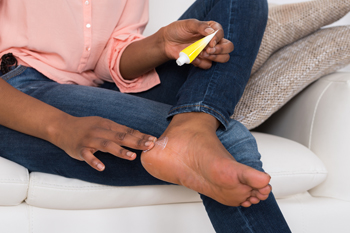
Cracked heels, also known as heel fissures, is a common and unsightly condition that negatively impacts the wellness of your feet. Simply put, this condition occurs when the skin surrounding the heel and bottom of the feet becomes exceedingly dry. This skin can crack, causing fissures. In many cases, this condition is harmless. However, cracked heels can be unattractive and, in severe cases, might lead to infection and swelling. If you are diabetic, you stand at an increased risk of suffering from cracked heels. This is because diabetes can make your feet dry and deprive the skin of necessary nutrients, making cracked heels more likely. Additionally, in some cases, diabetes can damage the nerves present in one’s feet, which can prevent sweat glands in the feet from releasing sweat. The deprivation of sweat can reduce the moisture in the feet, increasing the probability of the onset of cracked heels. Therefore, while cracked heels are not necessarily a sign of diabetes, diabetics can face an increased risk of suffering from this affliction. If you are a diabetic and want to protect yourself from cracked heels, consider contacting a podiatrist.
Cracked heels are unsightly and can cause further damage to your shoes and feet. If you have any concerns, contact Dr. Joshua David Scoll from Pennsylvania. Our doctor can provide the care you need to keep you pain-free and on your feet.
Cracked Heels
Cracked heels appear unappealing and can make it harder for you walk around in sandals. Aside from looking unpleasant, cracked heels can also tear stockings, socks, and wear out your shoes. There are several methods to help restore a cracked heel and prevent further damage.
How Do You Get Them?
Dry skin is the number one culprit in creating cracked heels. Many athletes, walkers, joggers, and even swimmers suffer from cracked heels. Age and skin oil production play a role to getting cracked heels as well.
Promote Healing
Over the counter medicines can help, especially for those that need instant relief or who suffer from chronic dry feet.
Wear Socks – Wearing socks with medicated creams helps lock in moisture.
Moisturizers – Applying both day and night will help alleviate dryness which causes cracking.
Pumice Stones – These exfoliate and remove dead skin, which allows for smoother moisturizer application and better absorption into the skin.
Change in Diet
Eating healthy with a well-balanced diet will give the skin a fresh and radiant look. Your body responds to the kinds of food you ingest. Omega-3 fatty acids and zinc supplements can also revitalize skin tissue.
Most importantly, seek professional help if unsure how to proceed in treating cracked heels. A podiatrist will help you with any questions or information needed.
If you have any questions, please feel free to contact one of our offices located in Philadelphia, Bensalem, and Fairless Hills, PA . We offer the newest diagnostic and treatment technologies for all your foot care needs.
Freiberg’s Disease
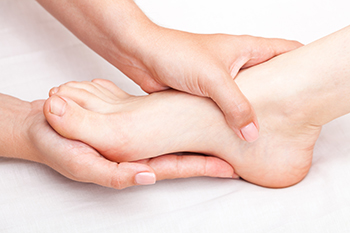
Freiberg’s disease, also known as Freiberg’s infarction or Frieberg's infraction, is associated with pain in the forefoot. It has to do with the softening of one of the metatarsal heads and typically occurs in teenagers that are growing. If excessive weight is put on this part of the foot, it can lead to a microfracture of the metatarsal head. Symptoms are swelling and discomfort at the ball of the foot and the joint associated with the affected toe – usually the base of the second toe. It is common for one with this affliction to have a long second toe that sustains repetitive force. A person with Freiberg’s disease might limp during the acute phase of the condition and it can become chronic before it is diagnosed. An X-ray or MRI can be used to help diagnose this disease and it is often treated non-invasively, with proper fitting shoes with a wide toe box and metatarsal pads to offset the pressure on the area. Sometimes a walker boot, cast, and/or anti-inflammatory medication is needed to offset weight bearing. There can be a residual deformity of the joint and discomfort that remains over time. However, rarely is surgery done to clean out the joint or shorten the metatarsal. If you/your child is experiencing pain and swelling near the ball of the foot, it is suggested you consult with a podiatrist who can take proper measures to detect the problem and treat it.
Some foot conditions may require additional professional care. If you have any concerns, contact Dr. Joshua David Scoll of Pennsylvania. Our doctor can provide the care you need to keep you pain-free and on your feet.
Rare Foot Conditions
The majority of foot conditions are common and can be treated by a podiatrist. Standard diagnostic procedures are generally used to identify specific conditions and treatment can be rendered. A podiatrist also treats rare foot conditions which can be difficult to diagnose and may need extra attention and care.
There are many rare foot conditions that can affect children. Some of these can include:
- Freiberg’s disease
- Kohler’s disease
- Maffucci syndrome
Freiberg’s disease - This can be seen as a deterioration and flattening of a metatarsal bone that exists in the ball of the foot. It typically affects pre-teen and teenage girls, but can affect anyone at any age. Symptoms that can accompany this can be swelling, stiffness, and the patient may limp.
Kohler’s disease - This often targets the bone in the arch of the foot and affects younger boys. It can lead to an interruption of the blood supply which ultimately can lead to bone deterioration. The patient may limp or experience tenderness, swelling, and redness.
Maffucci syndrome - This affects the long bones in a child’s foot leading to the development of abnormal bone lesions. They are benign growths and typically develop in early childhood and the bones may be susceptible to breaking.
A podiatrist can properly diagnose and treat all types of rare foot conditions. If your child is affected by any of these symptoms or conditions, please don’t hesitate to call our office so the correct treatment method can begin.
If you have any questions please feel free to contact one of our offices located in Philadelphia, Bensalem, and Fairless Hills, PA . We offer the newest diagnostic tools and technology to treat your foot and ankle needs.
Is My Toe Broken or Bruised?
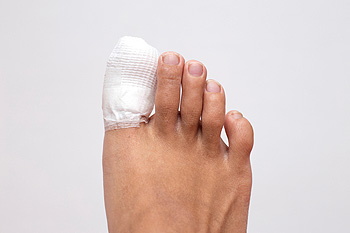
The most common method of differentiating between a broken toe and a bruised toe is to have an X-ray taken. They both can cause severe pain and discomfort. A severely broken toe can look deformed, and the bone can protrude from the toe at an abnormal angle. The symptoms that are associated with both of these types of injuries can include swelling, bruising, and difficulty walking. The buddy taping system for a bruised toe can cause the affected toe to feel better, as a result of the stability it provides. This is done by taping the toe to the toe next to it, and having it remain that way for several days. The buddy taping method works well for broken toes, as it causes the injured toe to remain still as the healing process occurs. In both scenarios, it is suggested to refrain from putting weight on the foot, which gives the broken or bruised toe ample time to heal. If you think you have broken or bruised your toe, it is advised to have it checked by a podiatrist who can guide you toward the proper treatment.
Broken toes may cause a lot of pain and should be treated as soon as possible. If you have any concerns about your feet, contact Dr. Joshua David Scoll from Pennsylvania. Our doctor will treat your foot and ankle needs.
What Is a Broken Toe?
A broken toe occurs when one or more of the toe bones of the foot are broken after an injury. Injuries such as stubbing your toe or dropping a heavy object on it may cause a toe fracture.
Symptoms of a Broken Toe
- Swelling
- Pain (with/without wearing shoes)
- Stiffness
- Nail Injury
Although the injured toe should be monitored daily, it is especially important to have a podiatrist look at your toe if you have severe symptoms. Some of these symptoms include worsening or new pain that is not relieved with medication, sores, redness, or open wounds near the toe.
If you have any questions, please feel free to contact one of our offices located in Philadelphia, Bensalem, and Fairless Hills, PA . We offer the newest diagnostic and treatment technologies for all your foot care needs.
More...
Achilles Tendon Injuries That Can Affect Athletes
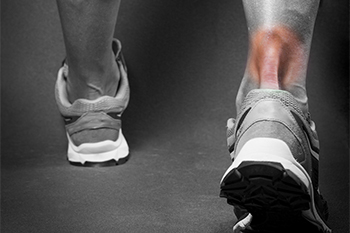
The long tendon that connects the heel bone with the calf muscles is called the Achilles tendon. The Achilles tendon is a critical component in running and walking, making it prone to wear injuries that can affect anyone. However, track and field athletes and those who play volleyball, softball, soccer, or racquet sports are more susceptible to these injuries. Pain in the lower calf, or at the back of the ankle may be indicative of an Achilles tendon injury. A common inflammatory injury to the Achilles tendon is tendonitis, which can cause sudden pain. Paratenonitis is another type of inflammatory issue which causes the covering of the Achilles tendon to thicken and inflame, thereby restricting the tendon’s movement. Tendinosis is a degenerative condition which weakens fibers in the tendon. Insertional Achilles Tendinopathy starts out with an inflammation of tendon fibers that attach to the heel bone, and then later degenerate. Athletes with any of these issues would do well to make an appointment with a podiatrist for proper diagnosis and treatment.
Ankle and foot injuries are common among athletes and in many sports. They can be caused by several problems and may be potentially serious. If you are feeling pain or think you were injured in a sporting event or when exercising, consult with Dr. Joshua David Scoll from Pennsylvania. Our doctor will assess your condition and provide you with quality foot and ankle treatment.
Common Injuries
The most common injuries that occur in sporting activities include:
- Achilles Tendonitis
- Achilles Tendon Rupture
- Ankle Sprains
- Broken Foot
- Plantar Fasciitis
- Stress Fractures
- Turf Toe
Symptoms
Symptoms vary depending upon the injury and in some cases, there may be no symptoms at all. However, in most cases, some form of symptom is experienced. Pain, aching, burning, bruising, tenderness, tightness or stiffness, sensation loss, difficulty moving, and swelling are the most common symptoms.
Treatment
Just as symptoms vary depending upon the injury, so do treatment options. A common treatment method is known as the RICE method. This method involves rest, applying ice, compression and elevating the afflicted foot or ankle. If the injury appears to be more serious, surgery might be required, such as arthroscopic or reconstructive surgery. Lastly, rehabilitation or therapy might be needed to gain full functionality in the afflicted area. Any discomfort experienced by an athlete must be evaluated by a licensed, reputable medical professional.
If you have any questions, please feel free to contact one of our offices located in Philadelphia, Bensalem, and Fairless Hills, PA . We offer the newest diagnostic and treatment technologies for all your foot care needs.
Bunions and Dancers
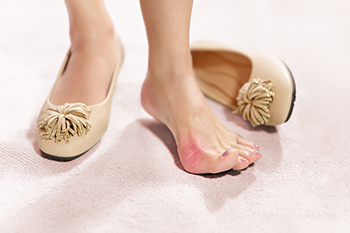
A bunion, hallux valgus, forms when there is a gradual change to the anatomy of the big toe leading to a deformity on the side of the toe that can be painful. This condition worsens when shoes are ill-fitting or have pointed toes that apply pressure to this toe. Dancers, especially ballet dancers (who dance in pointe shoes), are prone to this ailment but anyone can get a bunion. The main symptom of a bunion is a swollen, red area over the deformed joint of the big toe that is tender when touched. One can also experience numbness or a burning sensation if the surrounding nerves become irritated. The big toe angles in and irritation of the skin can lead to blisters or bursitis at the site of the bunion. When severe and long-standing, a bunion may cause the toes to overlap and arthritis, which causes additional pain when walking or performing activities that require one to push off with the feet. To prevent bunions, one can try to change their footwear to shoes that have more room in the toe box and that are wider, modify activities that cause pain, or wear shoe inserts or spacers. It is often recommended that dancers avoid bunion surgery until they stop dancing, as it may interfere with their ability to dance. If you have a bunion that is interfering with your life, consider seeing a podiatrist for proper diagnosis and treatment options.
If you are suffering from bunions, contact Dr. Joshua David Scoll of Pennsylvania. Our doctor can provide the care you need to keep you pain-free and on your feet.
What Is a Bunion?
A bunion is formed of swollen tissue or an enlargement of boney growth, usually located at the base joint of the toe that connects to the foot. The swelling occurs due to the bones in the big toe shifting inward, which impacts the other toes of the foot. This causes the area around the base of the big toe to become inflamed and painful.
Why Do Bunions Form?
Genetics – Susceptibility to bunions are often hereditary
Stress on the feet – Poorly fitted and uncomfortable footwear that places stress on feet, such as heels, can worsen existing bunions
How Are Bunions Diagnosed?
Doctors often perform two tests – blood tests and x-rays – when trying to diagnose bunions, especially in the early stages of development. Blood tests help determine if the foot pain is being caused by something else, such as arthritis, while x-rays provide a clear picture of your bone structure to your doctor.
How Are Bunions Treated?
- Refrain from wearing heels or similar shoes that cause discomfort
- Select wider shoes that can provide more comfort and reduce pain
- Anti-inflammatory and pain management drugs
- Orthotics or foot inserts
- Surgery
If you have any questions, please feel free to contact one of our offices located in Philadelphia, Bensalem, and Fairless Hills, PA . We offer the newest diagnostic and treatment technologies for all your foot care needs.
The Ankle and How It Moves

Understanding foot and ankle biomechanics can be helpful in maximizing the completion of everyday activities. Simply put, it is the way a person walks, moves, or runs. Gait is a style of walking and can involve different stages of movement. There are three components to the foot. The hindfoot is under the ankle joint. This is referred to as the back of the foot and is composed of two tarsal bones. The middle of the foot is known as the mid foot, as its name implies. This part of the foot contains five tarsal bones. Chopart’s joint is the name given where the midfoot and hindfoot connect. The front of the foot is known as the forefoot and includes the metatarsals, phalanges, and sesamoid bone. Each foot consists of 28 bones, and several ligaments, tendons, and muscles. They work together in absorbing shock and creating movement from the heels to the toes. The muscles in the back and front of the leg allow the foot to move up and down and there are specific muscles that enable the foot to point and flex. If you would like to learn additional information about what proper foot structure is responsible for, please consult with a podiatrist.
If you have any concerns about your feet, contact Dr. Joshua David Scoll from Pennsylvania. Our doctor can provide the care you need to keep you pain-free and on your feet.
Biomechanics in Podiatry
Podiatric biomechanics is a particular sector of specialty podiatry with licensed practitioners who are trained to diagnose and treat conditions affecting the foot, ankle and lower leg. Biomechanics deals with the forces that act against the body, causing an interference with the biological structures. It focuses on the movement of the ankle, the foot and the forces that interact with them.
A History of Biomechanics
- Biomechanics dates back to the BC era in Egypt where evidence of professional foot care has been recorded.
- In 1974, biomechanics gained a higher profile from the studies of Merton Root, who claimed that by changing or controlling the forces between the ankle and the foot, corrections or conditions could be implemented to gain strength and coordination in the area.
Modern technological improvements are based on past theories and therapeutic processes that provide a better understanding of podiatric concepts for biomechanics. Computers can provide accurate information about the forces and patterns of the feet and lower legs.
Understanding biomechanics of the feet can help improve and eliminate pain, stopping further stress to the foot.
If you have any questions please feel free to contact one of our offices located in Philadelphia, Bensalem, and Fairless Hills, PA . We offer the newest diagnostic and treatment technologies for all your foot and ankle needs.
Ankle Pain That Is Not From an Injury
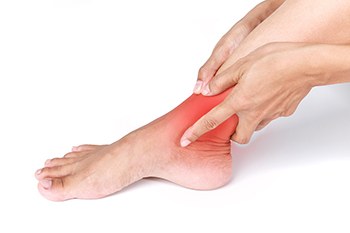
If your ankle hurts and you cannot recall doing anything that might have caused it, it could be a result of a type of arthritis, an autoimmune condition, or an infection. Obviously, the best treatment will depend on the root cause of the pain. Osteoarthritis is when the cartilage cushion between two bones gradually wears away, causing the bones to rub against each other. This might be painful, particularly upon arising, and it can come on suddenly. Rheumatoid arthritis is a chronic autoimmune disease when your body’s immune system begins attacking healthy tissue, including the lining of your ankle joints. This type of arthritis also causes pain, in addition to swelling and stiffness that begin in the toes and move toward the ankles. Fallen arches are when the tendons supporting the arches of the feet get damaged, the arches lose support and fall. An infection starting in a different part of your body may settle in the ankle joint. Any one of these ailments can cause ankle pain. If you feel such pain and believe you have not sustained an ankle injury, it is important to consult with a podiatrist for a proper diagnosis and treatment for the underlying cause.
Ankle pain can have many different causes and the pain may potentially be serious. If you have ankle pain, consult with Dr. Joshua David Scoll from Pennsylvania. Our doctor will assess your condition and provide you with quality foot and ankle treatment.
Ankle pain is any condition that causes pain in the ankle. Due to the fact that the ankle consists of tendons, muscles, bones, and ligaments, ankle pain can come from a number of different conditions.
Causes
The most common causes of ankle pain include:
- Types of arthritis (rheumatoid, osteoarthritis, and gout)
- Ankle sprains
- Broken ankles
- Achilles tendinitis
- Achilles tendon rupture
- Stress fractures
- Tarsal tunnel syndrome
- Plantar fasciitis
Symptoms
Symptoms of ankle injury vary based upon the condition. Pain may include general pain and discomfort, swelling, aching, redness, bruising, burning or stabbing sensations, and/or loss of sensation.
Diagnosis
Due to the wide variety of potential causes of ankle pain, podiatrists will utilize a number of different methods to properly diagnose ankle pain. This can include asking for personal and family medical histories and of any recent injuries. Further diagnosis may include sensation tests, a physical examination, and potentially x-rays or other imaging tests.
Treatment
Just as the range of causes varies widely, so do treatments. Some more common treatments are rest, ice packs, keeping pressure off the foot, orthotics and braces, medication for inflammation and pain, and surgery.
If you have any questions, please feel free to contact one of our offices located in Philadelphia, Bensalem, and Fairless Hills, PA . We offer the newest diagnostic and treatment technologies for all your foot care needs.



